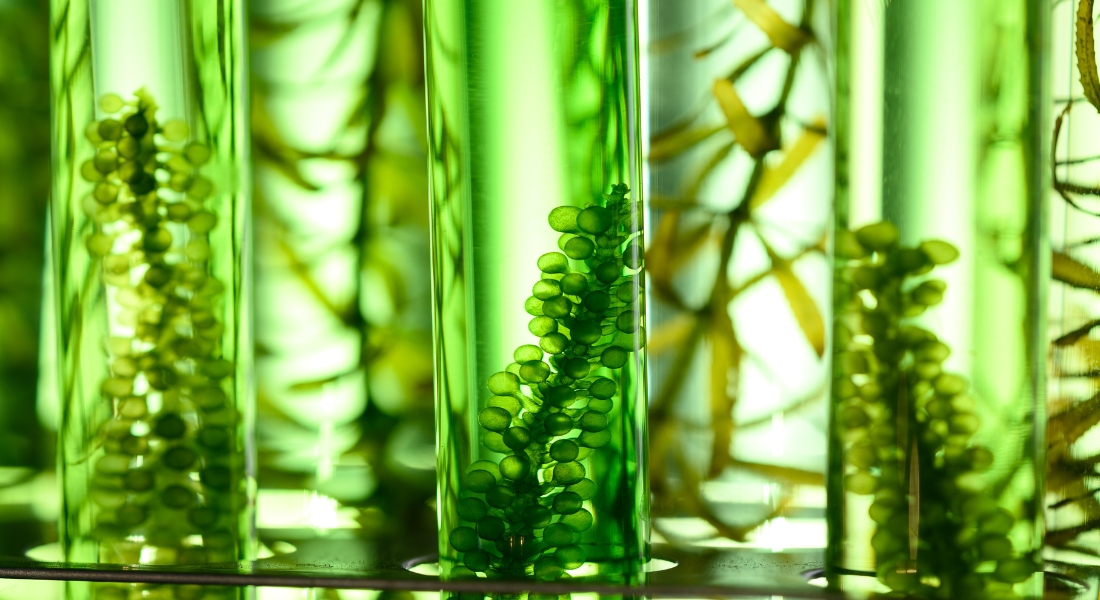In terms of biofuel advancement worldwide, Indonesia has been leading in production rate and blending rate. According to The Diplomat, Indonesia is now the world’s third biggest biofuel producer, behind only the United States and Brazil in 2019 [1]. Earlier in 2000, almost 90% of biofuel produced was conventional biofuel from feedstock, this results in competition with food consumption and production, which leads to development of more sustainable biofuels as these first generation biofuels’ sustainability were being questioned [2].
The use of scrap foodstock was introduced in second generation biofuel, with the introduction of a more sustainable third generation biofuel, using algae as its main source of biomass [3]. While there are many forms of biomass that can be used in order to generate bioenergy, one of the most promising prospects of microorganism is algae.

Gambar 1.1 Biofuel Alga
Even though it is still in the early stages, Algae biofuels have the potential to reduce greenhouse gas emissions and improve energy security in Indonesia, which aligns with the Ministry of Finance (Mrs. Sri Mulyani)’s goal of reaching net zero emission by 2060 [4]. Production, usage, and cultivation of algae is greatly suited for the climate and nature of Indonesia, with vast coastlines and abundant sunlights that can help provide needed nutrients to grow algae biofuels.
Due to uncertainty in biofuel demand in the long run, there are things that the government should act on in order to better use algae biofuel or biofuel as a whole in order to help realize net zero emissions, such as:
1. Develop long term strategies regarding biofuel and algae biofuel's role in energy transition, in order to achieve net zero.
2. Spread biofuel feedstock portfolio, due to current over-reliance on palm oil.
3. Finish government support through policies to motivate usage of second and third generation biofuels.
Lack of governmental support or incentives may hinder the improvement of second and third generation biofuels [5]. Financial help, support mandates, and other encouragements may be needed as research regarding second and third generation biofuels aren’t as advanced as first generation biofuels and non-food-crop feedstock biofuels which contribute to 91% of biofuel produced in 2018 [2].
References
[1] Haryanto, & Yusgiantoro, F. C. (2021, June 23). Indonesia Needs to Seek Out Alternative Sources for Biofuel. The Diplomat. Retrieved February 3, 2023, from https://thediplomat.com/2021/06/indonesia-needs-to-seek-out-alternative-sources-for-biofuel/
[2] IESR (2021). Critical review on the biofuel development policy in Indonesia
[3] Behera, S., Singh, R., Arora, R.,Sharma, N. K., Shukla, M., & Kumar, S. (2015). Scope of algae as third generation biofuels. Frontiers. https://doi.org/10.3389/fbioe.2014.00090
[4] Kementrian Koordinator Bidang Perekonomian Republik Indonesia (2022, October 25). Akselerasi Net Zero Emissions, Indonesia Deklarasikan Target Terbaru Penurunan Emisi Karbon. Ekon. Retrieved February 3, 2023, from https://ekon.go.id/publikasi/detail/4652/akselerasi-net-zero-emissions-indonesiadeklarasikan-target-terbaru-penurunanemisi-karbon
[5] Kusumawardhani, S. (2022, September 7). Diverse, sustainable biofuels crucial for Indonesia’s energy transition. This article was published in thejakartapost.com with the title "Diverse, sustainable biofuels crucial for Indonesia’s energy transition". Click to read:
Https://www.Thejakartapost.Com/business/2022/09/07/diverse-sustainable-biofuels-crucial-for-indonesias-energy-transition.Html. Download The Jakarta Post app for easier and faster news access: Android:Http://bit.Ly/tjp-android iOS:Http://bit.Ly/tjp-ios. The Jakarta Post. Retrieved February 3, 2023, from https://www.thejakartapost.com/business/2022/09/07/diverse-sustainable-biofuels-crucial-for-indonesias-energy-transition.html
This article is written by :
Reza Radinka
Sales & Marketing Staff





123456.webp)
12345.webp)